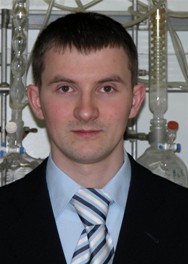Org. Synth. 2007, 84, 199
DOI: 10.15227/orgsyn.084.0199
ELECTROPHILIC CYCLIZATION WITH N-IODOSUCCINIMIDE: PREPARATION OF 5-(4-BROMOPHENYL)-3-IODO-2-(4-METHYL-PHENYL)FURAN
Submitted by Adam Sniady, Marco S. Morreale, and Roman Dembinski
1.
Checked by Cody Timmons and Peter Wipf
2.
1. Procedure
A. 1-(4-Bromophenyl)-4-methylphenyl)but-3-yn-1-ol (1). A 500-mL, three-necked, round-bottomed flask (Note 1), equipped with a magnetic stirring bar and fitted with a nitrogen inlet adapter and two rubber septa, is charged with THF (40 mL) (Note 2) and 4-ethynyltoluene (4.08 mL, 32.2 mmol) (Note 3) via syringes. The reaction vessel is placed in a dry ice-acetone bath. After 10 min, lithium diisopropylamide solution (LDA) (16.1 mL, 32.2 mmol) (Note 4) is added within 5 min via syringe to the stirred reaction mixture. The mixture is allowed to stir for 10 min after which time the bath is removed and the reaction vessel is allowed to warm to room temperature. Dimethyl sulfoxide (DMSO) (75 mL) (Note 5) is added over 5 min via syringe to the reaction vessel, followed by a solution of 4-bromostyrene oxide (4.94 g, 24.8 mmol) (Note 6) in 5 mL of THF over 1 min via syringe. The reaction mixture acquires a dark red wine color and is allowed to stir at room temperature for 2 h (Note 7). Then, the reaction flask is placed in an ice-bath and quenched with saturated aqueous ammonium chloride (100 mL). The mixture is transferred to a 500-mL separatory funnel using saturated aqueous ammonium chloride (50 mL) as a rinse. The aqueous phase is extracted with ether (3 × 150 mL). The combined ether extracts are transferred to a 1-L separatory funnel and washed with saturated aqueous sodium chloride (2 × 200 mL). The organic phase is dried with anhydrous sodium sulfate (10 g) and filtered through a fritted-glass funnel of medium porosity. The solvent is removed via rotary evaporation (23 °C, 25 mmHg) followed by high vacuum (23 °C, 0.6 mmHg, 3 h). The crude product is purified by recrystallization and chromatography of the mother liquor on SiO2 (Note 8) to yield 1 as a white crystalline solid (6.01 g, 19.1 mmol, 77%) (Note 9).
B. 1-(4-Bromophenyl)-4-methylphenyl)but-3-yn-1-one (2). A 500-mL, single-necked, round-bottomed flask equipped with a rubber septum and a magnetic stirring bar is charged with 1 (6.01 g, 19.1 mmol) and acetone (200 mL) (Note 10). Jones reagent (8.0 mL, 3.0 M solution, 24 mmol) (Note 11) is added by syringe over 5 min at 0 °C (ice-water bath) to the stirred mixture (Notes 12, 13). The bath is removed and the reaction mixture is allowed to stir for an additional 15 min (Note 7), then immediately ether (130 mL) and isopropanol (4 mL) are added. The blue-green solid is filtered off through a medium porosity glass funnel and the filtrate is transferred to a 1-L separatory funnel filled with 100 mL of ice water. Three extractions with ether (3 × 100 mL) are carried out. The combined organic phases are washed twice with saturated sodium bicarbonate (2 × 150 mL), dried over sodium sulfate (10 g), filtered, and concentrated at reduced pressure on a rotary evaporator (23 °C, 25 mmHg). The resulting light yellow solid is transferred to a 50-mL, single neck round-bottomed flask and dried for 6 h under vacuum (23 °C, 0.6 mmHg) to give 2 (5.56 g, 17.8 mmol, 93%), which is used in the next step without further purification (Note 14).
C. 5-(4-Bromophenyl)-3-iodo-2-(4-methylphenyl)furan (3). A 500-mL, three-necked, round-bottomed flask equipped with a magnetic stirring bar and a rubber septum is charged with 2 (5.10 g, 16.3 mmol). An additional rubber septum with a nitrogen inlet is attached to the remaining neck, and acetone (150 mL) (Note 10) is added via syringe. In a separate flask N-iodosuccinimide (NIS) (3.85 g, 17.1 mmol) (Note 15) is dissolved in acetone (60 mL). The solution of NIS is then injected via syringe over 5 min into the reaction mixture that is stirred at room temperature under a nitrogen atmosphere for 2 h. TLC analysis (Note 7) indicates a complete conversion. The solvent is removed by rotary evaporation (23 °C, 25 mmHg) and the residue is extracted with ether (150 mL) (Note 16). The solid (succinimide) is filtered off through a medium porosity glass funnel, and additionally washed with ether (60 mL) (Note 16). The ethereal extracts are combined and transferred to a 500-mL separatory funnel containing 50 mL of a 2.0 M aqueous sodium bisulfite solution. The phases are separated and the aqueous phase is further extracted with ether (3 × 50 mL). The combined organic extracts are washed with brine (1 × 100 mL) and dried over Na2SO4 (10 g). The mixture is filtered through a medium porosity fritted glass funnel and the solvent is removed by rotary evaporation (23 °C, 25 mmHg). The resulting material is charged on a column (3 × 40 cm) of silica gel (35 g) (Note 17) and eluted with hexanes/ethyl acetate (8:1) (approximately 600 mL) (Note 18). The product is concentrated by rotary evaporation (23 °C, 25 mmHg) and then dried at 0.6 mmHg (23 °C, 6 h) to yield 3 as a colorless solid (5.80 g, 13.2 mmol, 81%) (Note 19).
2. Notes
1.
The apparatus was oven-dried at 135 °C for 2 h and maintained under an atmosphere of dry nitrogen during the course of the reaction. The flasks had neck sizes of 24/40.
2.
THF was dried over sodium/benzophenone and freshly distilled under an atmosphere of dry nitrogen.
3.
4-Ethynyltoluene (98%) was purchased from GFS Chemicals and used as received. The checkers used chemicals from Alfa Aesar without further purification.
4.
Lithium diisopropylamide (2.0 M solution in THF/n-heptane) was purchased from Acros Organics and used as received.
5.
Methylsulfoxide, anhydrous, DriSolv was purchased from EMD Chemicals, Inc. and used as received. The checkers used 99.7% anhydrous DMSO from Acros Organics.
6.
4-Bromostyrene oxide (96%) was purchased from Aldrich Chemical Company, Inc. and used as received.
7.
The progress of the reaction was monitored by TLC analysis on silica gel eluted with hexanes/ethyl acetate (8:2) and visualized with phosphomolybdic acid. The R
f values were: 0.53 (blue) for 4-bromostyrene oxide, 0.32 (dark blue) for alcohol
1, 0.59 (blue) for ketone
2, and 0.74 (orange-brown) for furan
3.
8.
Ethyl acetate (15 mL) was added to the flask containing crude
1 (10.23 g). The flask was heated gently with a heat-gun under hand-stirring until the all of the crude material was dissolved. Then, the solution was layered with
hexanes (30 mL) and placed in the refrigerator (−6 °C) for 12 h to induce crystallization. The flask was placed in an ice-bath and the mother liquor was removed via syringe. The crystalline residue was rinsed with cold
hexanes (2 × 10 mL) (placed in an ice bath for at least 45 min prior to use) and the rinses were removed via syringe; then the crystalline material was dried (23 °C, 0.6 mmHg, 3 h) to afford
alcohol 1 (4.45 g, 14.1 mmol, 57%). The rinses were combined with the mother liquor and the solvent was removed via rotary evaporation (23 °C, 25 mmHg) followed by high vacuum (23 °C, 0.6 mmHg, 3 h) to yield 4.12 g of crude material. This material was dissolved in
ethyl acetate (10 mL) with hand-stirring and the help of a heat-gun. The flask was layered with
hexanes (20 mL) and placed in the refrigerator for 48 h. Then the crystallization flask was placed into an ice bath and the mother liquor was removed via syringe. The crystalline material was rinsed with cold
hexanes (10 mL) and the rinse was removed via syringe; then the crystalline material was dried (23 °C, 0.6 mmHg, 3 h) to afford an additional 6% of
alcohol 1 (0.46 g, 1.5 mmol). The rinses and mother liquor were combined and concentrated by rotary evaporation. The resulting material was charged on a column (3 × 40 cm) of silica gel (35 g) and eluted with
hexanes/ethyl acetate (6:1) (approximately 400 mL) to provide an additional 14% of
alcohol 1 (1.10 g, 3.49 mmol). The total amount of
alcohol 1 obtained in this reaction was 6.01 g (19.1 mmol, 77%).
9.
mp 133–135 °C (EtOAc/hexanes). Calcd for C
17H
15BrO: C, 64.78; H, 4.80. Found: C, 64.59; H, 4.85. IR (cm
−1, NaCl disk) 3411 (m), 1509 (m), 1046 (m), 817 (s). UV-Vis (, M
−1cm
−1; ether; 3.5 × 10
−5 M) 244 (29000), 254 (24000). MS (rel intensity) 185 (88), 130 (100), 115 (74), 77 (96), 63 (34).
1H NMR
pdf (300 MHz, CDCl
3) δ: 2.36 (s, 3 H), 2.61 (d, 1 H,
J = 3.0 Hz), 2.80–2.84 (m, 2 H), 4.90 (td, 1 H,
J = 6.3, 1.5 Hz), 7.12 (d, 2 H,
J = 7.8 Hz), 7.28–7.33 (m, 4 H), 7.47 (d, 2 H,
J = 8.4 Hz);
13C NMR
pdf δ: 21.4, 30.6, 71.9, 83.6, 84.5, 119.9, 121.6, 127.5, 129.0, 131.4, 131.5, 138.2, 141.6.
10.
High Purity Solvent grade purchased from Burdick & Jackson was used as received. The checkers used OmniSolv High Purity Solvent grade acetone from EMD Chemicals. For procedure B reagent grade acetone can be used.
11.
Prepared according to ref.11.
12.
Precipitation of blue-green chromium (III) salts was observed.
13.
Reaction can be carried out in an open flask.
14.
The light yellow solid had a purity of approximately 95% as determined by NMR. A portion of the material (0.46 g) was retained for recrystallization as described in
Note 8 to afford colorless crystals for analytical data: mp 121–123 °C (EtOAc/hexanes). Calcd for C
17H
13BrO: C, 65.19; H, 4.18. Found: C, 65.33; H, 4.14. IR (cm
−1, NaCl disk) 1677 (s), 809 (s). UV-Vis (, M
−1cm
−1; ether; 4.5 × 10
−5 M) 254 (35000). MS (rel intensity) 312 (M
+, 53), 183 (100), 155 (60), 129 (74%).
1H NMR
pdf (CDCl
3) δ: 2.33 (s, 3 H), 4.02 (s, 2 H), 7.09 (d, 2 H,
J = 7.8 Hz), 7.31 (d, 2 H,
J = 8.1 Hz), 7.61 (d, 2 H,
J = 8.4 Hz), 7.91 (d, 2 H,
J = 8.4 Hz);
13C NMR
pdf δ: 21.3, 31.5, 80.9, 85.7, 119.7, 128.7, 128.9, 130.1, 131.4, 131.9, 134.1, 138.3, 192.1.
15.
NIS was obtained from Simafex and used as received. The checkers used NIS from Alfa Aesar.
16.
Ether (unstabilized) was purchased from EMD Chemicals, Inc. and used as received. The checkers used diethyl ether that was freshly distilled from sodium/benzophenone. Extraction with ether stabilized with ethanol led to “leaching” of the succinimide.
17.
Sorbent Technologies 60 Å, 230–400 mesh.
18.
Flash column chromatography was performed in order to remove residues of succinimide. The solid was dissolved in a minimum amount of hexanes/ethyl acetate (8:1) and loaded onto the column. Pressured air was applied and one fraction was collected.
19.
mp 98–100 °C (EtOAc/hexanes). Calcd for C
17H
12BrIO: C, 46.50; H, 2.75. Found: C, 46.72; H, 2.74. IR (cm
−1, NaCl disk) 1492 (s), 1475 (s), 1400 (w), 946 (s), 816 (s). UV-Vis (e, M
−1cm
−1; ether, 2.5 × 10
−5 M) 237 (23000), 253 (22000), 330 (35000). MS (rel intensity) 438 (M
+, 100), 283 (M – C
6H
4Br, 70).
1H NMR
pdf (CDCl
3) δ: 2.42 (s, 3 H), 6.83 (s, 1 H), 7.28 (d, 2 H,
J = 8.1 Hz), 7.48–7.59 (m, 4 H), 7.94 (d, 2 H,
J = 8.1 Hz);
13C NMR
pdf δ: 21.4, 62.1, 116.1, 121.7, 125.2, 126.1, 127.2, 128.5, 129.1, 131.9, 138.4, 151.7, 152.6.
Handling and Disposal of Hazardous Chemicals
The procedures in this article are intended for use only by persons with prior training in experimental organic chemistry. All hazardous materials should be handled using the standard procedures for work with chemicals described in references such as "Prudent Practices in the Laboratory" (The National Academies Press, Washington, D.C., 2011 www.nap.edu). All chemical waste should be disposed of in accordance with local regulations. For general guidelines for the management of chemical waste, see Chapter 8 of Prudent Practices.
These procedures must be conducted at one's own risk. Organic Syntheses, Inc., its Editors, and its Board of Directors do not warrant or guarantee the safety of individuals using these procedures and hereby disclaim any liability for any injuries or damages claimed to have resulted from or related in any way to the procedures herein.
3. Discussion
The furan ring is a key component of many pharmaceutical agents, fragrances, natural products, and organic materials. Halofurans allow for further functionalization of the ring, usually via transition metal-catalyzed coupling reactions; they serve as starting materials for combinatorial chemistry.
3 The title molecule includes differently halogenated furan and phenyl rings that can be further functionalized.
The method described herein applies electrophilic cyclization for the synthesis of unsymmetrical 3(
beta)-iodofurans, with different, but electronically similar substituents in the 2- and 5- (
alpha) positions. The method is of general use; other 3-halo (iodo- and bromo-) furans can also be synthesized in a regioselective manner (Table 1),
4 using other electrophilic reagents (ICl, NBS, and Br
2). This approach provides a facile, non-acidic, non-basic, non-transition metal based protocol, in which an easy to handle reagent
5 facilitates cyclization and serves simultaneously as a halogen donor. The reaction conditions are mild (room temperature in acetone). The yield is high, the reaction time is relatively short (0.5–2 h), and the isolation procedure is simple.
The best current alternatives for the synthesis of 2,5-unsymmetrically substituted 3-iodofurans include: a) Hydriodic acid cyclization of 4-hydroxybut-2-yn-1-ones.
3,6 This procedure features a strong acid. b) Iodocyclization (3 equiv of iodine) of alk-3-yn-1,2-diols that requires the use of a base.
7 c) Sonogashira coupling-addition-cyclocondensation one-pot procedure that starts from acyl chlorides and terahydropyranyl ethers of propargyl alcohols.
8Alkynol
1 was prepared by a known method.
9 It was observed by
1H NMR that the ring opening of the 2-(4-bromophenyl)oxirane proceeded in a completely regioselective manner. BF
3•Et
2O was not used as an additive, as reported.
10 THF and DMF were found to be inefficient solvents for this protocol. Alkynone
2 was prepared by oxidation of the alkynol
1 with CrO
3 (Jones reagent).
11 Among other oxidation methods screened, Dess-Martin periodinane
12 was comparable. Jones oxidation for relevant compounds has been reported with low,
13 reasonable,
14,15 and high yields.
16 No experimental procedure, however, was provided for the high yielding example. A catalytic oxidation protocol has also been described.
17 Alk-3-yn-1-ones are reportedly prone to isomerization to the corresponding allenes,
17,18 but this is not pertinent for the procedure for
2, presumably due to the triple bond stabilization by the conjugated phenyl ring. Alkynone
2 was found to be stable as a solid (stored in a freezer); cycloisomerization was observed when
2 was left for a prolonged time in solution. Cycloisomerization of homologous alk-3-yn-1-ones to the non-halogenated furans has been reported to proceed efficiently with the use of metal catalysts such as Hg,
16 Au,
19 Pd,
15,20 or Zn
21 derivatives.
Table 1. Preparation of other halofurans via electrophilic cyclization.4
|
|
Entry
|
R
|
R'
|
E-A, solvent
|
Yield (%)
|
|
|
1
|
C6H5
|
p-CH3C6H4
|
NBS, acetone
|
89
|
|
2
|
|
|
NIS, acetone
|
84
|
|
3
|
|
|
ICl, CH2Cl2
|
82
|
|
4
|
p-BrC6H4
|
p-CH3C6H4
|
NBS, acetone
|
89
|
|
5
|
|
|
NIS, acetone
|
86
|
|
6
|
p-ClC6H4
|
p-CH3C6H4
|
NBS, acetone
|
83
|
|
7
|
|
|
NIS, acetone
|
94
|
|
8
|
p-BrC6H4
|
p-t-BuC6H4
|
NBS, acetone
|
87
|
|
9
|
|
|
NIS, acetone
|
81
|
|
10
|
p-ClC6H4
|
p-t-BuC6H4
|
NBS, acetone
|
86
|
|
11
|
|
|
NIS, acetone
|
88
|
|
Appendix
Chemical Abstracts Nomenclature (Collective Index Number);
(Registry Number)
5-(4-Bromophenyl)-3-iodo-2-(4-methylphenyl)furan; (852211-52-0)
2-(4-Bromophenyl)oxirane:
(4-Bromostyrene oxide); (32017-76-8)
4-Ethynyltoluene; (9766-97-2)
Lithium diisopropylamide; (4111-54-0)
1-(4-Bromophenyl)-4-methylphenyl)but-3-yn-1-ol; (852211-40-6)
Chromium trioxide; (1333-82-0)
1-(4-Bromophenyl)-4-methylphenyl)but-3-yn-1-one; (852211-45-1)
N-Iodosuccinimide (NIS); (516-12-1)
 |
Roman Dembinski was educated at the Polish Academy of Sciences, Centre of Molecular and Macromolecular Studies, Lódz, Poland (Ph.D. with A. Skowronska). Before, he completed his undergraduate studies at the Technical University of Lódz. He then joined the research group of J. A. Gladysz at the University of Utah as a research associate. Since 1999 he has held a faculty appointment at the Oakland University, Rochester. His scientific interests include synthetic organic, fluorous, medicinal, and organometallic chemistry.
|
 |
Adam Sniady obtained his M.S. in chemistry from the Technical University of Lódz, Poland, in 2004. Earlier, he received M.S. in Biology from the University of Lódz. He is currently pursuing a Ph.D. with Roman Dembinski at the Oakland University, Rochester, Michigan, USA. His research is focused on developing new synthetic methodologies, including electrophilic cyclizations and synthesis of modified nucleosides.
|
 |
Marco Morreale obtained his B.A. in chemistry from Wayne State University (Detroit, Michigan) in 1999. During his undergraduate years, his introduction to chemical research began in the laboratory of Norman Lebel. He entered the graduate program in chemistry at Oakland University (Rochester, Michigan) in the fall of 2004. Under the direction of Roman Dembinski, he is currently investigating cyclization strategies for the synthesis of substituted furans.
|
 |
Cody Timmons received his B.S. (2000) and M.S. (2002) degrees in Chemistry from West Texas A&M University in Canyon, Texas. His M.S. research was performed under the direction of Professor Darren Williams and dealt with the kinetics of the degradation of explosives. He then moved to Texas Tech University in the fall of 2002 and joined the group of Professor Guigen Li, where he studied novel olefin addition and carbon-carbon bond formation methodologies. He completed his Ph.D. in 2006 and is currently a postdoctoral research associate in the lab of Professor Peter Wipf at the University of Pittsburgh, where he is pursuing the total synthesis of ergot and clavine alkaloids.
|
Copyright © 1921-, Organic Syntheses, Inc. All Rights Reserved